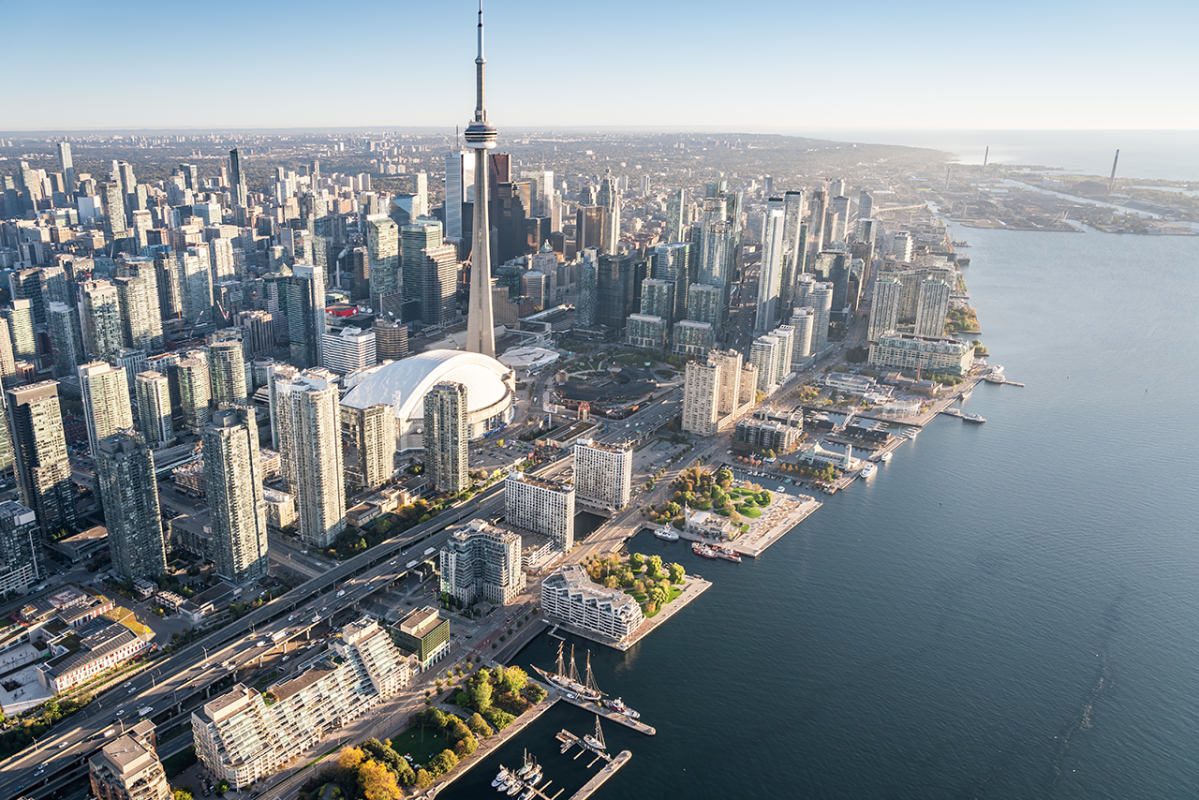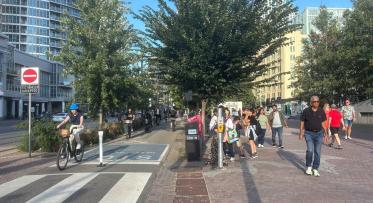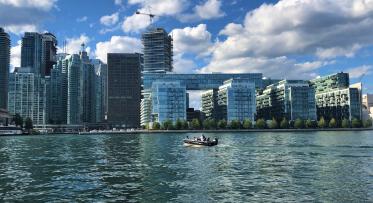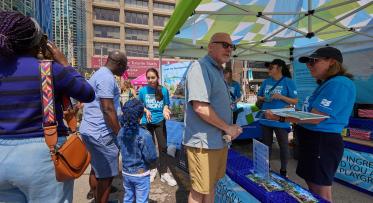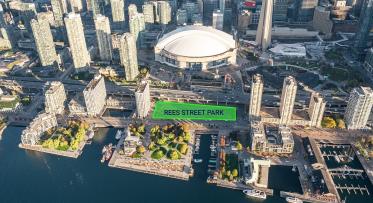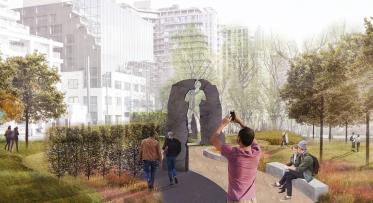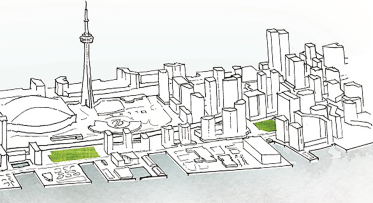Central Waterfront
We are transforming the most heavily used part of Toronto’s waterfront by giving it a bold new look and unified design.
Waterfront Toronto is working to transform the central waterfront area to allow it to live up to its remarkable potential.
Working with a comprehensive plan by West 8 + DTAH, the winners of the 2006 Central Waterfront Innovative Design Competition, Waterfront Toronto is implementing a remarkable vision for the area that will link major waterfront destinations, create new public spaces and give the city the grand waterfront boulevard it deserves.
Ultimately, the goal is to create a powerful, world-class identity for the central waterfront that celebrates the Canadian lakefront experience and provides the public with access to the water’s edge.
Plans for the Area
In addition to the uniquely Canadian wave decks we’ve built at the Spadina, Simcoe and Rees slips, we are revitalizing the central waterfront by:
- Building a new Queens Quay - the completed revitalization has turned Queens Quay West into a waterfront boulevard with space for everyone, including a generous, tree-lined promenade and cycling connections that transform the area into a vibrant people place
- Creating a continuous water’s edge promenade and boardwalk connected by dramatic timber footbridges
- Encouraging lively marine activity with the installation of a series of finger piers; and
- Connecting the entire waterfront using a consistent palette of trees, furnishings and materials such as granite paving surfaces, cedar and ipe wood decking and benches, brushed stainless steel railings and timber and aluminum light poles.
Quick Facts
Boundaries:
From Bathurst Street to Lower Jarvis Street, south of Lake Shore Boulevard to Lake Ontario
Size:
- 2.5 km stretch along most well-developed part of downtown Toronto’s waterfront
- Water’s edge promenade and boardwalk: 1.8 km long by 12 m wide promenade and 8 m wide boardwalk connected by five timber footbridges
- Pedestrian Promenade: 1.5 km long by approximately 5 m wide from Yo Yo Ma Lane to Bay Street
- Martin Goodman Trail: 1.5 km long by approximately 3.6 m wide off-street multi-use trail from Yo Yo Ma Lane to Yonge Street Design Team: West 8 + DTAH
Central Waterfront Design Competition
Waterfront Toronto held an innovative design competition in 2006 to select the best plan to convert Toronto’s central waterfront into a spectacular public waterfront destination.
While there had been much development in the area over the past few decades, there was no coherent look or feel and it was difficult to distinguish public space from private space along the shoreline.
The challenge outlined in the design competition brief was to connect and enhance existing public spaces like the Music Garden and to provide a distinct and uniform identity for all public spaces along Toronto’s downtown waterfront.
Thirty-eight teams from 15 countries on four continents responded to a Request for Qualifications and five teams were short-listed and asked to participate in the competition. Following an extensive public consultation process including public exhibitions across the city, the jury unanimously selected the design concept by West 8 DTAH. The jury felt the design proposed a clear, simple and strong vision that could be implemented in the near future to create much needed public access to the waterfront.
Review the full Jury Report.
From Vision to Plan
Construction is now complete on the new Queens Quay - an economically vibrant and scenic waterfront boulevard that prioritizes transit and completes the Martin Goodman Trail through the central part of the waterfront. Before construction began, Waterfront Toronto held a 10-day public installation called Quay to the City to help people experience the winning design. The installation, which was launched in the summer of 2006, showed how the revitalization of Queens Quay could transform the area into an active and vibrant waterfront boulevard. In 2007, Waterfront Toronto began work on an extensive Environment Assessment for Queens Quay that rigorously tested alternatives and obtained public feedback. When the EA was approved in mid-2010, detailed design began and was followed by an extensive planning for construction process.
Given the amount of planning required for Queens Quay, Waterfront Toronto began transforming the central waterfront by designing, constructing and opening three wavedecks at the heads of the Spadina, Rees and Simcoe slips. These must-see wavedecks, which opened in 2008/2009, helped build momentum for waterfront revitalization until the Environmental Assessment was complete. We also transformed a parking lot at Harbourfront Centre into new public squares and we’ve built a new stretch of promenade at the Portland Slip.
Engaging the Community
Planning for the Central Waterfront is a collaborative process that occurs during design and construction. Since the Innovative Design Competition in 2006, Waterfront Toronto has worked closely with community stakeholder groups, landowners and the general public. Over the years we have held waterfront tours, workshops, working groups, stakeholder and public meetings. Meetings are promoted in our newsletter and in our online calendar.
Subscribe to the Waterfront Toronto newsletter
Design Consultation
After the Environmental Assessment was approved in 2010, Waterfront Toronto established the Queens Quay Working Group to give interested stakeholders an opportunity to provide input during the detailed design process. The Working Group met monthly from July 2010 until planning for construction began in earnest in late 2011. As part of its mandate, the Working Group provided feedback on topics such as streetscape design, bus management strategy, wayfinding and signage, traffic planning and construction phasing.
Construction Consultation
During Queens Quay construction, Waterfront Toronto used a number of different ways to engage in effective two-way communication with stakeholders including neighbourhood update meetings, weekly (and as-needed) construction notices and the Constructing Queens Quay website.
Another way we engaged with stakeholders was through the Queens Quay Construction Liaison Committee (CLC). The Queens Quay CLC provided a forum for residents, businesses and neighbourhood groups in the project area to discuss construction-related issues. The committee met with the project team and construction manager on a monthly basis to learn about construction plans and to give input on any impacts the community may be experiencing. CLC members were committed to representing their communities/groups by providing feedback, advice and recommendations to the project team. The CLC included a representative of every condo on Queens Quay as well as a strong representative of business and advocacy groups.
Queens Quay Opening
Since the official opening of the revitalized Queens Quay West in June 2015, we have continued to connect with stakeholders and the general public, providing updates on how the new street is working and accepting feedback on its new design and configuration.

